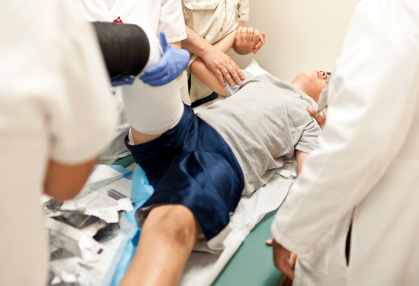
In all cases of fractures and dislocations, the person should not be moved unless danger is present in the environment. Basic first aid requires that the injured bone, even the limbs, should not be realigned or pushed back. Moreover, it should not be allowed to move at all. Provide soft paddings and slings to support the position chosen by the person. Apply ice to the fractured or dislocated limb. These should reduce swelling and pain. The rescuer should check and monitor for circulation, ensuring that the injured area has continuous blood flow or nerve sensations. Emergency medical assistance should be called immediately. Fracture injuries in the limbs vary in first aid treatment. This is because of the different types and shapes of the bones in the body,
When the arm is fractured, the weight of the elbow and the lower arm is supported by the person to minimize pain. Fracture of the upper arm may be grave due to the pressure on the major nerves and blood vessels, especially the ones adjacent to the shoulder and elbow joints. Help the person into the most comfortable position, usually sitting on a chair or half sitting with assistance. Place the injured arm of the person on a pillow or folded clothing. While waiting for emergency help, apply an elevation sling to minimize the injured arm’s movements.
If the lower arm or wrist is fractured, the injured arm of the person may be supported with the other arm. Help the person into the most comfortable position, usually sitting down with the weight of the injured wrist against the body. To give support, a pillow or clothing may be placed on the lap to give a soft support for the patient to use so he/ she can rest the burden of the arm. While waiting for emergency help, utilize a firmly folded newspaper folded into a gutter shape and use as a splint under the fractured wrist. Use a narrow-fold bandage above and below the injured limb to keep the splint in position. Arm slings may be applied for supplementary support and stability.
The same treatment can be given to a fractured hand and fractured or dislocated finger. Do not attempt to move replace the dislocated finger, only a medical professional may do so. To relieve of pain, soft padding may be applied around the injured hand and/ or fingers. Apply an elevation sling, taking extra precaution to prevent hitting the injured area when tying the knot.
Oftentimes, it is hard to determine whether a person has suffered a fracture of sprain in the ankle. However, when there is doubt, treat the injury as a fracture. The same treatment may be given to fractured or dislocated foot or toe/s. Help the person to lie down
and elevate the injured ankle/ or foot on soft padding. This will remove the weight from the injured food and minimize swelling and pain. Do not remove the shoes to prevent any further injury unless there is a suspected open wound. A soft pillow or rolled blanket may be utilized to immobilize the injured area. To keep the padding in place, make use of a two narrow-fold bandage.
Although these injuries are fairly common only in sports, medical assistance is required for any type of bone injury. The sooner first aid is performed on victims, the greater chances of minimizing damages. Through first aid training and various other workplace approved programs, the lay community can provide to victims to minimalize pain in emergency situations such as these.
